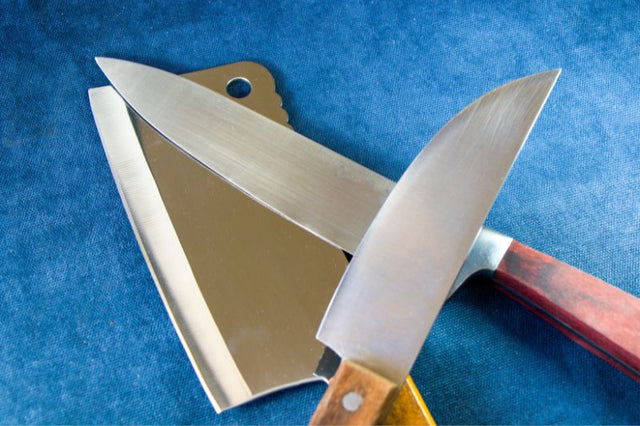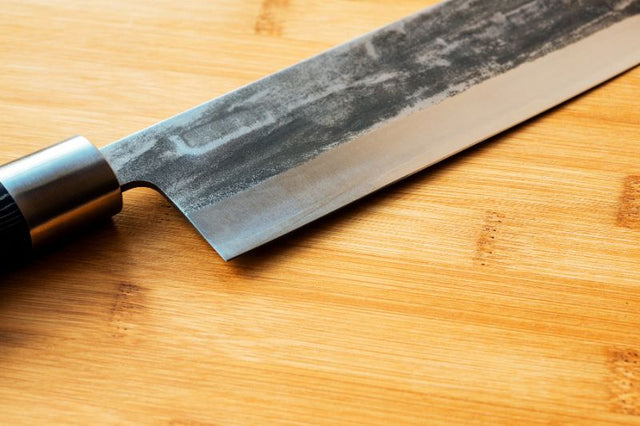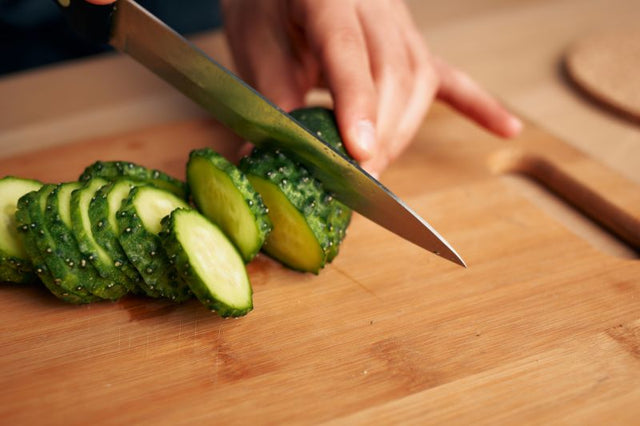Japanese knives are of good quality, to the point expert chefs worldwide use these. These knives come with many looks and use. For now, we will learn about the two bevels of Japanese knives and how these affect the slices.
A bevel is a slanted or angled surface, usually at the edge of a blade. In the context of knives, a bevel refers to the angled surface created when a blade is sharpened. A single bevel refers to a blade with only one angled surface, while a double bevel refers to a blade with two angled surfaces with the same angle on both sides. The angle of the bevel can affect how the knife cuts, with a steeper angle providing a sharper edge, but also making the knife more fragile. The shape of the bevel can also affect the knife's performance, with different bevel forms providing different levels of sharpness and durability.



What is a Single Bevel Knife?
A single bevel knife is known as one-sided knife or chisel edge knife, is a knife that is sharpened on only one side of the blade. This type of knife is typically used for tasks such as traditional Japanese sushi and sashimi preparation or for left-handed individuals. The blade's unsharpened side is generally thicker and flatter, which can help guide the knife through certain types of food. Some examples of single bevel knives include a Deba knife, Yanagiba knife, and an Usuba knife. These knives are commonly used in Japanese cuisine, but can also be used for other types of precision cutting tasks.

What is a Double Bevel Knife?
A double bevel knife, also known as a V-edge or symmetrical edge knife, is a type of knife that is sharpened on both sides of the blade at the same angle. This type of knife is more versatile and is commonly used for a variety of tasks in Western cooking. The angle of the blade on a double bevel knife can vary, affecting how it slices through different types of food. Common examples of double bevel knives include chef's knife, utility knife, paring knife, and serrated knife. These knives are suitable for various tasks such as chopping, slicing, and dicing vegetables, fruits, meats, and fish.


Is there a difference in slicing with single bevel or double bevel knives?
Single bevel knives are primarily associated with Japanese cuisine. They are traditionally used in Japanese kitchens for specific tasks, such as slicing vegetables, filleting fish, or preparing sashimi. Some common types of single bevel knives include:
Usuba: A traditional Japanese vegetable knife used for slicing and cutting vegetables.
Deba: A heavy knife used for filleting fish and breaking down poultry.
Yanagiba: A long, thin knife for slicing sashimi and other raw fish dishes.
Honesuki: A heavy, triangular knife that breaks down poultry and other meats.
Single bevel knives are less common in Western kitchens but are growing in popularity as more people become interested in traditional Japanese cooking techniques. They can take some getting used to, as the asymmetrical shape of the blade requires a different cutting technique, but they can be a valuable addition to a cook's knife collection for specialized tasks.
It is not a matter of preference between single bevel and double bevel knives for Japanese chefs. Instead, it is a matter of using the right tool for the right task.
While many traditional Japanese knives are single bevel, some are double bevel. Here are a few examples of double bevel Japanese knives:
Santoku knife: A Japanese all-purpose knife similar to a Western chef's knife.
Gyuto knife: A Japanese chef's knife used for various tasks such as chopping, mincing, slicing, and dicing.
Sujikiri Knife: A long, thin knife for slicing meats, fish, and vegetables.
Nakiri knife: A rectangular knife for cutting vegetables, similar to Usuba, but with a double bevel blade edge.
These Japanese knives are double beveled, making them easier to use and maintain than single bevel knives. They are popular among Japanese home cooks and professional chefs and are also growing in popularity in Western kitchens. Double bevel Japanese knives are well-balanced, sharp, and durable, making them valuable to any cook's knife collection.


There is a difference between slicing with a single bevel knife and a double bevel knife.
A single bevel knife, also known as a chisel edge or bevel edge knife, has only one angled side, which makes it ideal for precise cutting tasks, such as filleting fish, or making clean cuts through thicker, tougher ingredients like carrots, or slicing through hard cheese.
A double bevel knife, also known as a V-edge knife, has two angled sides that converge to a sharp point. These angles make it easier to use for various cutting tasks, as the blade can be used on either side to make right or left-handed cuts. As a result, double bevel knives are generally more versatile and easier to use than single bevel knives, making them a more popular choice among home and professional cooks.
In general, single bevel knives are better suited for specialized tasks that require a high degree of precision, while double bevel knives are a more all-purpose option for general cutting and slicing tasks. Japanese chefs tend to use a combination of both single bevel and double bevel knives, depending on the task at hand. They recognize the unique benefits of each type of knife and choose the one that best fits the job.
Which is better? Single bevel or double bevel knife?
Whether a single bevel knife or a double bevel knife is better depends on your specific needs and preferences.
Single bevel knives are ideal for precise cutting tasks, such as slicing raw fish for sushi or sashimi, or peeling and shaping vegetables in Japanese cuisine. They offer more control and precision in cutting, but require more skill and experience to use effectively.
In conclusion, both single bevel and double bevel knives have their own unique advantages and disadvantages, and the better choice depends on what type of tasks you will be using the knife for and your level of skill and experience. A single bevel knife may be the better choice if you're looking for a specialized tool for a specific task. A double bevel knife is probably a better option if you need a versatile, all-purpose knife.
Get Free Bonus Books

Sign up for free to the Japanese Knife Club to get advice and exclusive articles about how to choose Japanese Knives, and tips and tricks for using Japanese knives.
About the author
Kei Nishida
Author, CEO Dream of Japan
Certification: PMP, BS in Computer Science
Education: Western Washington University
Kei Nishida is a passionate advocate of Japanese craftsmanship, a writer, and the founder and CEO of Japanese Knife Co., Japanese Green Tea Co., and Japanese Coffee Co., all part of Dream of Japan.
His journey began with a mission to introduce the world to the exquisite flavors of Japanese green tea. Through Japanese Green Tea Co., he pioneered the import of premium tea grown in nutrient-rich sugarcane soil, earning multiple Global Tea Champion awards. He then expanded into the world of coffee, launching Japanese Coffee Co., the first company to bring Sumiyaki charcoal-roasted coffee to a global audience.
With a deep appreciation for Japanese artistry and tradition, Kei turned his attention to one of Japan’s most revered crafts: bladesmithing. Through Japanese Knife Co., he made handcrafted katana-style knives, created by a renowned katana maker, available outside Japan for the first time. These exceptional knives embody centuries of samurai sword-making expertise, blending tradition with modern functionality for chefs and collectors alike.
Kei’s journey continues as he uncovers and shares Japan’s hidden treasures—one sip, one blade, and one legacy at a time.



















